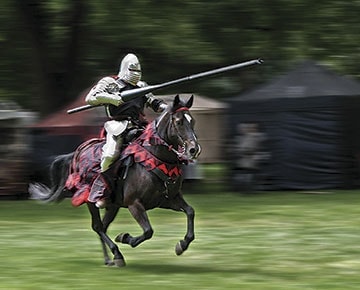Archaeological excavations are held and festival of medieval culture is organised on Zamkovaya Mountain in Mstislavl
Every summer Mstislavl holds the festival of medieval culture. This place is chosen not by chance. After all, it is difficult to find a more picturesque city for such a holiday in the east of Belarus. All is impregnated with spirit of olden times here.
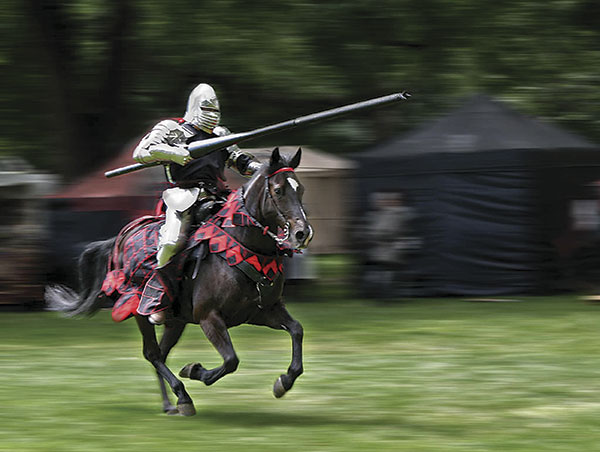
If you go here for the first time, it may seem to you that Mstislavl is a village. Wooden houses with multi-coloured cases, carved in the way that they differ from each other, dazzle in the window of a car. Ah, you exclaim, saying that it is such a picturesque village! But suddenly from behind the hills there appear crosses of the Roman Catholic Church and the Orthodox Church, while wooden houses standing along the road change to strong houses from red brick. They were built more than one hundred years ago. And all this has survived, people still live here.
Mstislavl`s traditions of spending holidays with knightly fights and fairs of handicraftsmen are several years old. And each time here appears a certain new sight which attracts tourists. While the Zamkovaya mountain fits well into the district, where guys in chain armours show the skills of sword play. Local organisers erect monuments to commemorate the great predecessors of modern athletes in armour: earlier it was stones in honour of Simeon Lugven who was the son of Algirdas, Mstislavl prince, and in memory of the unknown soldier of the early 16th century, whose armour was found in the river Vikhra. While this year there was built a chapel in honour of Saint prince Rostislav Mstislavich — he is considered to be the founder of the city. It was he who named the settlement after his father.

One of the most ancient cities of the Eastern Europe now lives partly in the past, which is felt here almost in each street, and partly — in the present. This is a unique potential of Mstislavl which can tell you about the history and life of our ancestors better than any textbook.
I follow the city streets, and see memorial plaques in honour of Piotr Mstislavets, one of the first printers, Ivan Nosovich, the author of the first Belarusian-Russian dictionary, poet Arcady Kuleshov, historian Mikhail Tkachev; these plaques testify that here is the old kernel of culture and spirituality.
Walls of old monasteries and Catholic churches still need restoration, but you have no doubts looking at them that this old centre of princedom, province, district not only was, but also will be one of the well-known cities.

If I appeared in Mstislavl for the first time and did not know that the festival of medieval culture is held here, I would think that the atmosphere of traditional fairs was restored here. In old times, fairs were seldom held in cities or settlements, mainly once a year — on a big church holiday. And it was the main event in economic and cultural life of a city or village and their vicinities. And the Mstislavl festival has already been such an event for several years. The unique architectural and natural landscape of the city, and efforts of local authorities attract thousands of visitors.
The only problem is how to get there. A long road leads from Minsk to Mstislavl. Even by car and at full speed, without stops, the way takes more than 4 hours. While by public transport you will spend half a day. However, there is hope that in the future the same beautiful four-lane highway that leads from the capital to Mogilev will appear here. It is like a simple arrow — it is directed towards the regional centre. While there is an hour drive from Mogilev to Mstislavl.
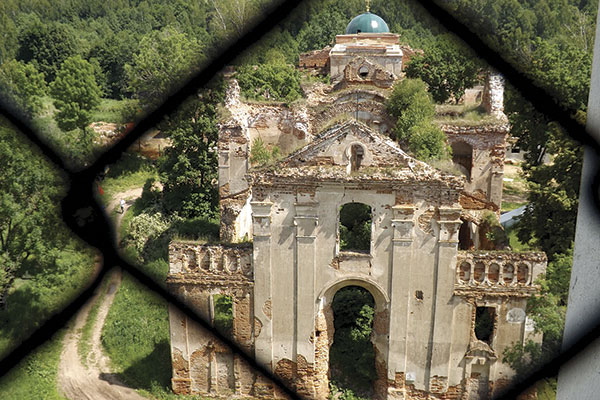
And here you are on the spot. While first of all it is necessary to make the way to the Zamkovaya mountain where the main participants of the festival — knights struggle in many duels. There are a lot of spectators — like on a football match. People filtered through the narrow pass between strong defensive ramparts of the citadel. And all people support with inspiration. Here appears a knight from Minsk — the ‘stands’ make a lot of noise. People from Novogrudok — applaud, from Zaslavl — exclaim. Here is a local Mstislavl fighter — so people with loud applause show ‘who’s wearing the pants in this family’. While the local fighter in response smartly shows his worth: riding in an apparently effortless manner, he takes a spear and throws up a red rag high into the sky. Such simple competition makes some warriors to become nervous: not all cope with the task.
Dance and theatre groups, craftsmen both from Belarus, and from neighbouring Russia gathered here. More than 20 knightly clubs. Tournaments, horse entertainments, competitions of archers, night tourneys, a storm of the castle, a master class of fighting skill — all this impresses. Specially for the night storm of the castle, archers had built a fortress which participants burnt with the help of fiery arrows. It is possible to see such things only at the cinema or in Mstislavl. The medieval atmosphere of the holiday was supported with performances of stars of Belarusian folklore — groups Litoy Taler, Melnitsa Solntsa, Stary Olsa. While the group Yavaryna gave a master class of medieval dances to spectators.
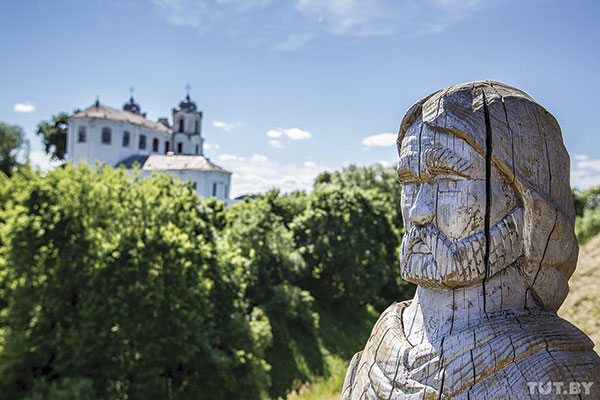
The Mstislavl festival gives a unique possibility to see rich the historical past and architecture of the ancient city. I approach shops which sell strange things made by masters from Rechitsa. They offer to buy real steel gloves for knights. The gloves are not medieval, but modern, however in appearance they are almost equal to those I saw in museums. The sellers allow me to try them on. They are not the right size and are intended for the strong hand of a fighter, not a writer. As for comfort — they are ideal: they fit better, than mittens. The secret is simple: they are metal only outside, while from the side of the palm — they are from fabric. You can buy such ‘accessory’ and put it on a bookshelf in order to surprise guests when they come. It they ask whence is such a thing, it is possible to dream up — from ancestors...
The rich heritage of our ancestors inspires people in different cities of the country to organise knightly clubs and to learn ancient customs. How to rekindle a fire with the help of cap and flint — handicraftsmen showed me how to do that as well. And you can also buy special devices in a leather sack for that. But I did not buy them. Maybe someone else will need them more. Because at home I have a gas cooker and an electric kettle. While if you are an inveterate fan of walking trips, then having such ancient ‘lighter’ you will be a real object of envy of friends. As it is a real art — to make flinty sparks!
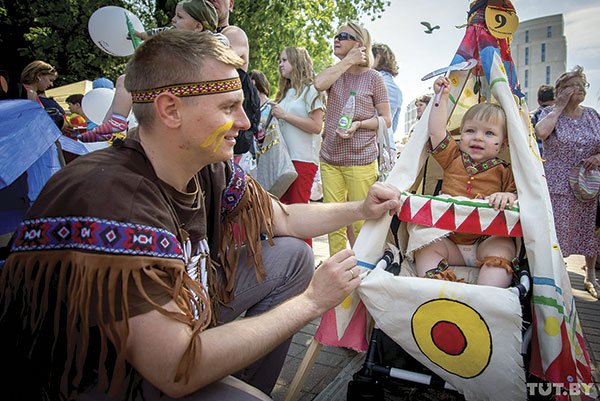
The art which can be mastered only by real romanticists — is how to sew a costume which was fashionable in the past centuries. Or how to make a royal marquee. While participants of the festival as though studied this since childhood. In such costumes they do not look strange people — it seems, that they live and dress in such a way every day. So they behave themselves according to role. All the same, we can see them unusual — only on holidays similar to the Mstislavl holiday.
Such festivals have one good feature — they give a possibility to meet the past face to face.
While in Mstislavl the holiday of medieval culture becomes also an occasion to open many sights which are usually closed. By my estimations, three Catholic churches and four, or even five monasteries have remained. From them, only the Cathedral of the Assumption of the Blessed Virgin Mary operates today. Meanwhile divine services are held in a small chapel. Other inside premises are ‘guarded’ with falsework which was put here in the 1970s. The restoration had been started, but was not completed (by the way, among those who made contribution to the important matter of preservation of the monument of architecture are well-known writers and artists Vladimir Stepan and Adam Globus).
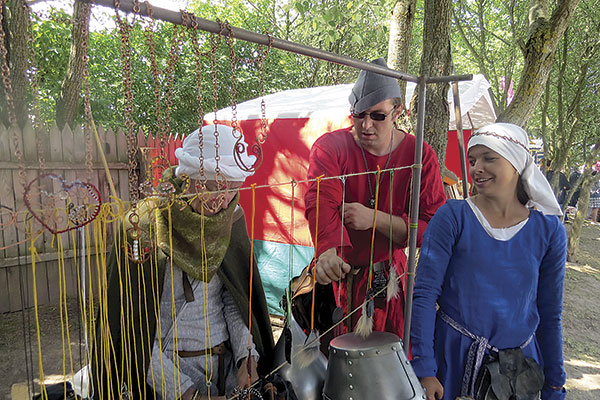
Several years ago, the hall where sounded prayers to God was filled up with falsework. Now all has changed: the church space has been released from all superfluous. It is possible to walk between columns, to walk up on the tower, to see indescribable beauty of the panorama from the Zamkovaya mountain, to go down to the underground and, passing under low arches, to feel as if being a monk of the order of Carmelites. The local museum of local history regularly organises exhibitions in the cellar. It is only necessary to wait for return of professionals who will restore the former appearance of masterpiece of architecture, because the church is famous — it is included into the history of Belarusian art, painted by beautiful frescos.
After buying a magnet with Mstislavl`s coat of arms in the ‘city of masters’, and after trying cherries and pies of villagers from neighbouring villages, I leave Mstislavl with hope that the Holiday of medieval culture will be held here not once a year, and will become a year-round holiday. It has all inclinations to become the same gem, as famous Mir and Nesvizh.
Mstislavl is half a century older, than it was considered earlier. This was announced by the Head of Chair of Archaeology and Special Historical Sciences of the Mogilev State A. Kuleshov University, Doctor of Historical Sciences Igor Marzalyuk. Experts of the Ministry of Forestry managed to define a new date of appearance of the city. They used dendrochronological method and examined annual rings of wood of fragments of the most ancient oak roadway, that they received from archaeologists. Igor Marzalyuk asserts that the whole city was constructed between 1098 and 1101, “Annals sources show that except the wooden roadway, the earlier origin of the city is proved by other wooden constructions which are dated to an earlier period. Mstislavl is mentioned in the annals for the first time in 1156 as a fortress on the western border of the Smolensk princedom.”
This year during archaeological excavations on the Zamkovaya Mountain there was found a bronze icon of 13th-14th century with the image of Roman emperor Constantine and his mother Helena. The place of excavations on the mountain will be turned into a museum. A special group of restorators will work on preservation of wooden constructions and details of roadways using special synthetic substances thanks to which they will remain even for long decades and will be available for tourists. Excavation will be defended from the sun and rain by a wooden construction which will simulate a princely tower. Discoveries will be shown here: items from metals, glass, timber, clay and bone, fabric, numerous decorations and tableware.
By Viktar Korbut









